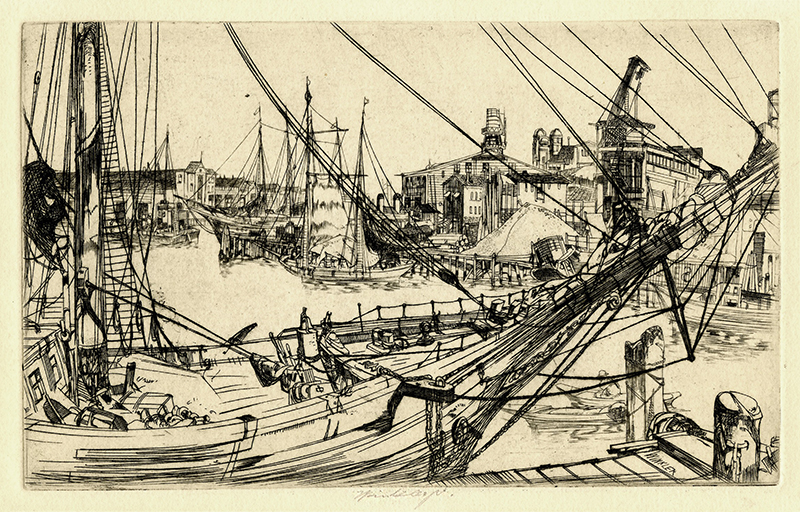Mission Street Wharf (Plate B, small) is an etching from 1917 by American artist John William Winkler. It is pencil signed beneath the platemark and inscribed Mission Street Wharf along the lower sheet edge. This etching was printed by the artist on ivory wove paper in an unknown edition and the platemark measures 4-7/16 x 7-3/16 inches.
Mission Street Wharf (Plate A, large) is illustrated on pages 72-73 in Master of Line: John W. Winkler—American Etcher. Mary Millman and Dave Bohn discuss this work and Winkler’s shift from Chinatown subjects to the waterfront: ‘In 1917, however Winks was content with the rigorous application of his newly acquired judgment. Thus, in the new waterfront subject matter developed in 1917, he can be observed unconsciously taking from his technical storehouse “whatever the subject required.” Building on the wharfside perspective he experimented with in the plate Irmgard, from the edge of San Francisco’s China Basin he needled one of his most famous images, erroneously titled from the day of its creation Mission Street Wharf. Interestingly, this plate was perfectly executed in its plein air version and resisted his later efforts to improve it. He made it larger, smaller, and even took a “detail” from its center. Yet the most he could ever bring himself to alter was the number of gulls in the air.’
Upon close inspection of this impression of Mission Street Wharf (plate b, small) versus the larger plate illustrated over pages 72 and 73, one can discern many differences—so many, in fact, that it appears that Winks etched an entirely new plate for this smaller version.
John William Joseph Winkler, painter, printmaker, draftsman and craftsman, was born in Vienna, Austria on July 30, 1890. He departed Austria in 1910, changed his name to John William Winkler on a forged passport, and immigrated to the United States. Winkler claimed to have been born in the year 1894 but he most likely changed his birth year along with his name on his counterfeit passport. He enrolled in the Mark Hopkins Art Institute (later to become the San Francisco Art Institute) in 1912 and produced his first etching the following year. Winkler became a naturalized citizen in 1921.
Winkler was a member of and exhibited with the Chicago Society of Etchers, the California Society of Etchers, the Society of American Graphic Artists, the San Francisco Art Association, and the Printmakers Society of California. In 1920 he won his third Logan Prize from the Chicago Society of Etchers. Winkler was elected an Associate in the National Academy of Design in 1936 and to full Academician in 1951. One of the highest tributes he received was from his friend and fellow etcher, John Taylor Arms, who proclaimed Winkler to be the “master of line,” the “master of us all.”
In 1955, an exhibition of Winkler’s etchings was mounted at the Kunstzaal Binsbergen in Arnhem, Holland and, in 1974, a solo exhibition of his etchings, drawings, and carved boxes was displayed at the California Palace of the Legion of Honor in San Francisco. The Brooklyn Museum presented John W. Winkler: Drawings, Prints, Boxes in 1979.
John William Winkler is represented in the collections of the Blanton Museum of Art, Austin, Texas; the National Gallery, the Smithsonian American Art Museum, the Library of Congress, Washington, D.C.; the Boston Public Library; the Art Institute of Chicago; the Delaware Art Museum, Wilmington; the Metropolitan Museum, the New York Public Library, New York; the Oakland Museum of California; the Philadelphia Museum of Art; the Rhode Island School of Design Museum, Providence; the Fine Arts Museums of San Francisco and the San Francisco Public Library; the Clark Museum, Williamstown, Massachusetts; and the Victoria and Albert Museum, London.
J.W. Winkler (known as “Winks”) died in El Cerrito, California in January 26, 1979.



